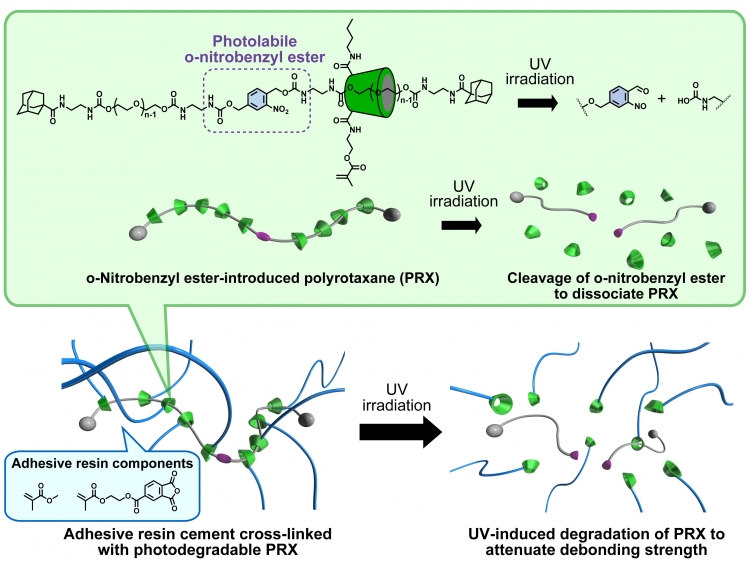Reversible Stickiness is Something to Smile About
Tokyo – Everyone who has had tooth cavities filled knows that the best dental materials stay where the dentist puts them. The adhesion of currently available dental materials to tooth surfaces continues to improve, but what about short-term treatments that are not supposed to adhere indefinitely? TMDU researchers have developed a method of making dental materials easier to remove; their findings are published in ACS Applied Polymer Materials.
The continual improvement of long-lasting caries treatments can be regarded a triumph of dental material research. However, there are dental procedures that require non-permanent adhesion to the tooth surface, such as the fixing of orthodontic brackets. Removing adhered materials after such procedures generally requires mechanical detachment that can damage tooth enamel.
Efforts to improve removal processes have produced materials that are weakened by triggers, such as heat or electric currents. However, approved sources of these stimuli are not readily available in standard dental clinics. The researchers therefore focused on UV light-responsive materials that can be triggered by the UV sources widely used by dentists to cure resin cements and composites.
The toughness of many dental cements is a result of mixing them with a cross-linker that locks the cement molecules to each other to form a stable network. The researchers have introduced a chemical ‘switch’ into a new cross-linker that opens when UV light is shined on it.
“The cross-linker structure resembles rings threaded onto a piece of string with bulky stoppers at each end,” study lead author Atsushi Tamura explains. “We have added a section to the string—an o-nitrobenzyl ester group—that breaks under UV light causing the rings to slide off. This has a significant effect on the stability of the cement material the cross-linker is holding in place.”
The researchers used their cross-linker to stabilize a commercially available resin cement that was used to stick two polymer blocks together, or to attach a polymer block to a bovine tooth. After shining UV light on the cross-linked cement for just 2 minutes, the cement showed a significant reduction in adhesion strength in both tests, meaning separation of the bonded materials was easier following UV treatment.
“We are very encouraged by the initial findings using our cross-linker,” study corresponding author Nobuhiko Yui explains. “Although the UV wavelength used to disrupt the material was not clinically appropriate in this case, we intend to develop the chemistry of our internal switch so that it can provide a facile and readily accessible method of removing adhesives in the clinic.”

UV light-embrittled dental resin cement containing photodegradable polyrotaxane cross-linkers.
To facilitate the debonding of dental restorative materials adhered on tooth surfaces, UV light-embrittled dental resin cement containing photodegradable polyrotaxane (PRX) cross-linkers was developed. PRX is a supramolecular interlocked polymer composed of α-cyclodextrin threaded on a linear polymer chain capped with bulky stopper molecules. The photodegradable PRXs containing photolabile o-nitrobenzyl ester was newly designed and used as a cross-linker of dental resin cements. The UV irradiation cleaves o-nitrobenzyl ester and the PRXs are dissociated, leading to decreasing the adhesive force of the dental resin cements. The plastic block was adhered on to the surface of bovine dentin using adhesive resin cement cross-linked with photodegradable PRXs, and the adhesive strength between plastic and dentin was clinically acceptable value. By contrast, the adhesive force was decreased by approximately 60% through the irradiation of UV light for 2 min, due to the photodegradation of PRX cross-linkers. This result suggests that the adhesive resin cement containing photodegradable PRX cross-linkers is a promising candidate for facilitating the debonding of dental materials from tooth surfaces via UV light irradiation.
The article, “Light-Embrittled Dental Resin Cements Containing Photodegradable Polyrotaxane Cross-Linkers for Attenuating Debonding Strength”, was published in ACS Applied Polymer Materials (DOI: https://doi.org/10.1021/acsapm.0c01024).
At the same time, the article was selected to be featured as ACS (American Chemical Society) Editors’ Choice (on 25th November, 2020) based on recommendations by ca. 70 ACS journals' editors due to its potential for broad public interest, an honor given to only one article from the entire ACS portfolio each day of the year.
Correspondence to
Department of Organic Biomaterials,
Institute of Biomaterials and Bioengineering,
Tokyo Medical and Dental University (TMDU)
E-mail:yui.org(at)tmd.ac.jp
*Please change (at) in e-mail addresses to @ on sending your e-mail to contact personnels.

